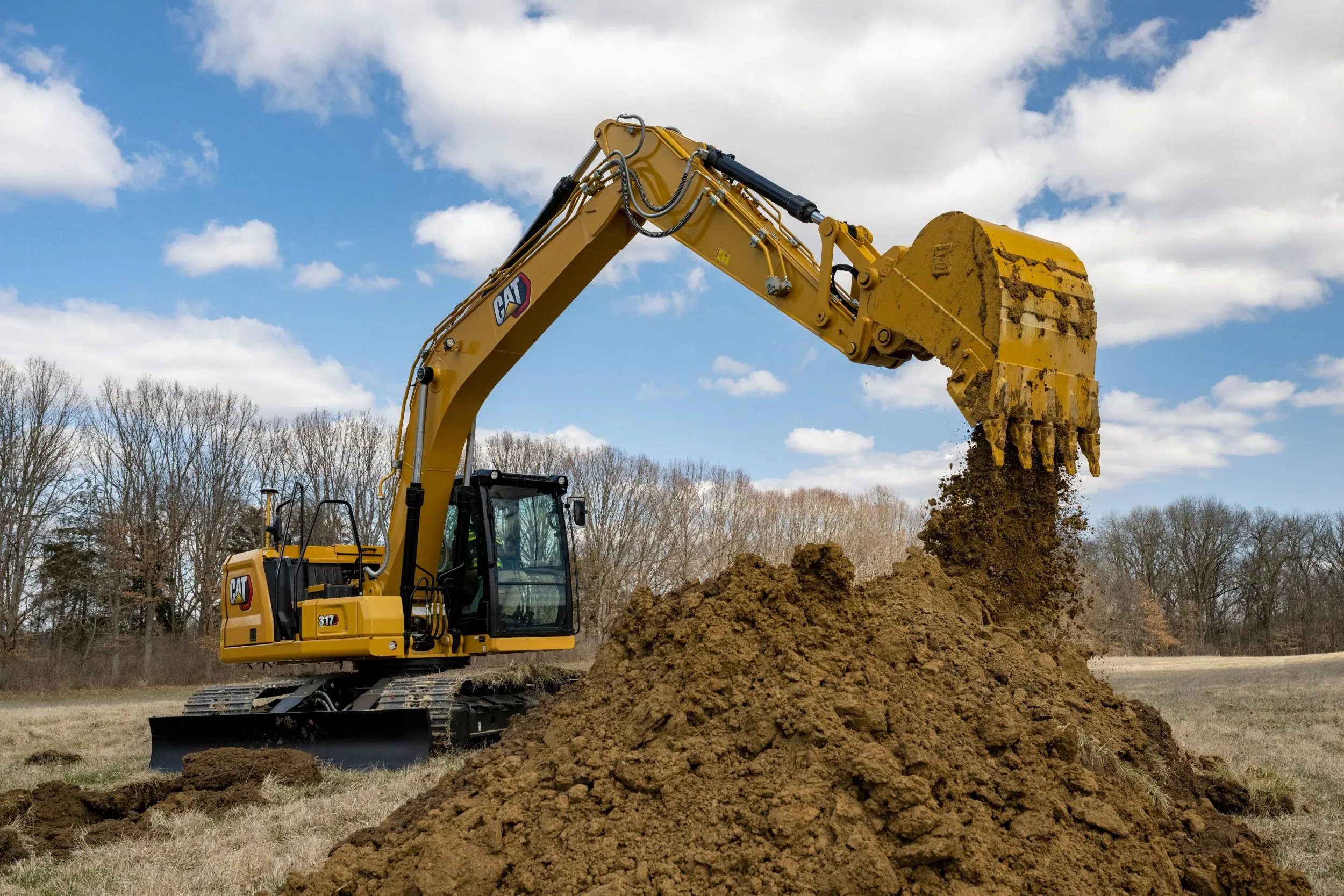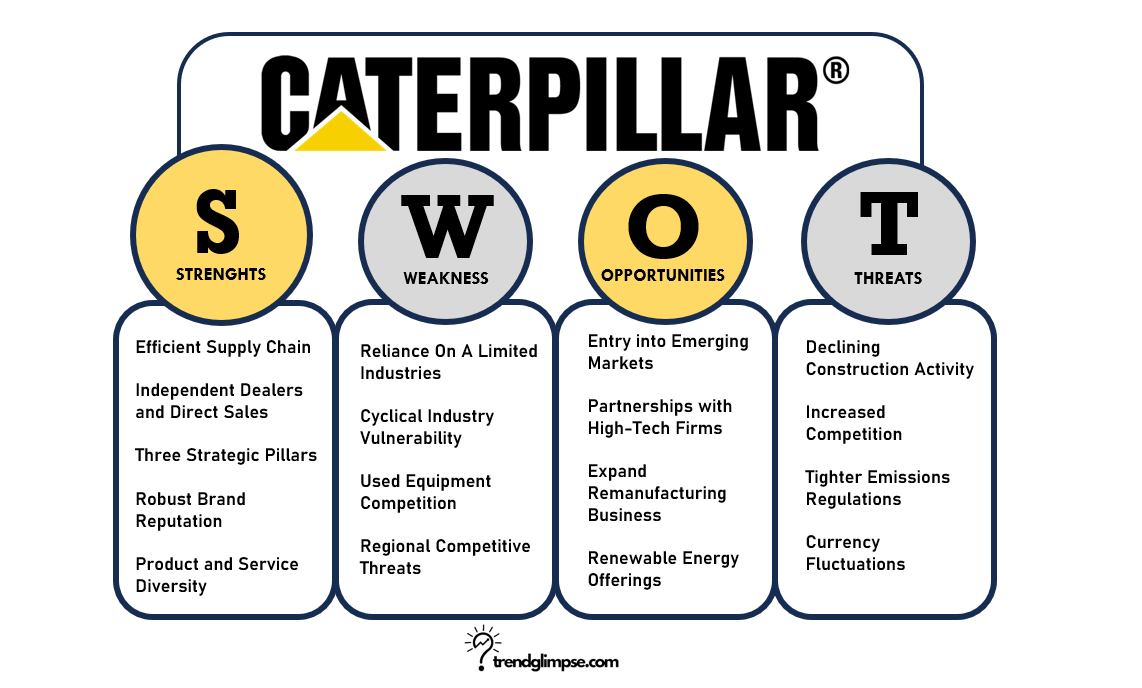An Overview of Caterpillar
Caterpillar’s innovative products and solutions can be found enabling progress at job sites and plants worldwide. As the world’s foremost producer of construction and mining machinery, Caterpillar Inc. also manufactures diesel and natural gas engines that power industrial facilities across the globe. Additionally, the company is an industry leader in the creation of diesel-electric locomotives and gas turbines used in the energy sector.
You’ve probably seen their bright yellow bulldozers and excavators on construction sites before.
Headquartered in Deerfield, Illinois, Caterpillar is a Fortune 100 company and a component of the Dow Jones Industrial Average. Caterpillar has been around since 1925 and sells machinery in over 180 countries. Their equipment ranges from small skid-steer loaders all the way up to 400-ton mining trucks. No matter what the job, they aim to have the right tool for it.
Headquarters: Irving, Texas, United States
Industry: Heavy equipment & Machinery
Current CEO: Jim Umpleby
Annual Revenue [2022]: US$ 59.4 Billion
Employee Count: ~109,100
Website: caterpillar.com
Caterpillar Inc. recently announced third quarter 2023 sales and revenues of US$ 16.8 billion, a 12% increase versus the third quarter of 2022. This growth aligns with Caterpillar’s strong performance so far in 2023 as construction activity has rebounded from pandemic lows.
To balance out equipment sales, Caterpillar has focused on growing its services business, which provides more stable revenue from offerings like maintenance and monitoring solutions. Geographically, Caterpillar generates most revenues in North America and Asia Pacific. Profit margins have averaged 8-10% in recent years, and the company maintains a strong balance sheet.
Construction Industries, Resource Industries, Energy & Transportation, Financial Products & Services
Brand Portfolio of Caterpillar
Anchor, AsiaTrak, Cat, Cat Financial, Cat Lift Trucks, Cat Reman, Cat Rental Store, FG Wilson, Hindustan, MWM, MaK, Perkins, SPM Oil & Gas, Progress Rail, SEM, Solar Turbines, Turner Powertrain Systems
Competitiors of Caterpillar
Komatsu, John Deere, Volvo Construction Equipment, Hitachi Construction Machinery, Liebherr, JCB (J.C. Bamford Excavators), Doosan Infracore, Kobelco Construction Machinery, Sany Group, Terex Corporation, CNH Industrial (Case Construction), Hyundai Heavy Industries, Manitowoc Cranes, XCMG Group, Atlas Copco
Strengths of Caterpillar
Well-Established and Efficient Supply Chain
One major strength of Caterpillar is their well-established and efficient supply chain. They have manufacturing operations and suppliers spanning the globe, which allows them to efficiently meet customer demand across industries and regions.
This global scale and reach is something many competitors struggle to match. It also gives Caterpillar an advantage when it comes to managing costs and maintaining profitability across business cycles.
Extensive Network of Independent Dealers and Direct Sales
Another key strength is Caterpillar’s extensive network of independent dealers and their model of selling both direct and through dealerships. Their dealer network provides outstanding product support and customer service in the field.
At the same time, their direct sales model allows them to engage with and tailor solutions for their largest clients. This the best of both worlds – the local touch of dealerships and the customization of direct sales. It has served them well over the years and built trust in the Caterpillar brand.
Business Approach Focusing on Three Strategic Pillars
Caterpillar’s business approach focuses on three strategic pillars that position it for continued success.
First is operational excellence – continuously improving safety, quality, cost management, and lead times. This drives efficiency and reliability for customers.
The second pillar is expanded offerings and services, like digital technologies and automation. This provides holistic solutions for customers managing change.
Lastly, the third pillar is winning portfolio – investing in the most profitable business segments aligned to industry trends. This balanced approach has served Caterpillar well over the years. Their disciplined strategy sustains their competitiveness.
Robust Brand Reputation
Additionally, Caterpillar benefits from a robust brand reputation built over decades. With a heritage dating to 1925, it’s one of the most established and trusted brands in equipment manufacturing. Through economic ups and downs, Caterpillar has maintained a reputation for quality, durability and customer service. Their trademark yellow machines are well-known across worksites.
Caterpillar’s brand and legacy inspires loyalty, allowing it to stand apart from competitors. It also provides an edge when introducing new solutions. Customers trust the brand and are willing to consider and pay for innovations with the Cat name attached. The brand equity Caterpillar has developed is a significant intangible asset.
Product and Service Diversity
Caterpillar has an immense product and service portfolio spanning a wide range of equipment, technologies and financial services. Their diverse machinery includes excavators, loaders, trucks and more, meeting needs across industries like construction, mining, energy and transportation. They also provide extensive parts and maintenance services supporting equipment life cycles. Additionally, Caterpillar offers advanced technologies for automation, operation efficiency and safety. Financial services like leasing options are another area of diversity.
This broad range allows Caterpillar to meet varied customer needs and adapt as industries evolve. Construction clients benefit from a completely different suite of offerings than mining operators. Having diversity mitigates risk, as downturns in one market are offset by stability in others. It also provides revenue streams across economic cycles. When mining slowed, construction improved.
Caterpillar’s ability to shift focus allows it to capitalize on the most lucrative segments at any given time. Few competitors match this degree of diversity across products and services. It makes Caterpillar a more resilient, full-solutions provider customers can rely on through industry ups and downs.

Weakness of Caterpillar
Reliance On A Limited Number Of Industries
Although Caterpillar operates across many industries, it relies heavily on just a few for revenue – mainly construction, mining, and energy. This concentration creates risk, as downturns in any of these sectors significantly impact Caterpillar’s results.
For example, around 60% of Caterpillar’s sales are from construction and mining. When mining declined in 2015, Caterpillar felt major effects, posting multiple quarters of steep revenue decreases. Reliance on key industries makes them vulnerable. Diversifying into more segments could mitigate this weakness.
Cyclical Industry Vulnerability
Additionally, the industries Caterpillar serves tend to be highly cyclical based on commodity prices, economic trends, and infrastructure demand. This subjects Caterpillar to market ups and downs outside of their control. During recessions or periods of reduced mining/drilling, Caterpillar’s sales routinely take large hits.
While they try adjusting inventory and costs, Caterpillar ultimately cannot escape broader industry cycles that dictate customer demand. Their inherently cyclical business, concentrated in a few sectors, causes financial performance swings that are challenging to manage. A more diversified customer base could smooth out these highs and lows.
Used Equipment Competition
Caterpillar faces increasing competition from used and rental equipment alternatives. Used machinery is often cheaper upfront. Rental equipment also allows flexibility. This pressures Caterpillar’s new equipment sales, especially during downturns as buyers look for value.
Competitors further enable used equipment options. Caterpillar must balance supporting used markets while ensuring used product availability doesn’t overly cannibalize new sales. Managing this threat will require strategic pricing and inventory management. Failure to do so could structurally impact revenue and market share.
Regional Competitive Threats
Regionally, Caterpillar faces strong competition from domestic champions in China and Japan. Companies like Komatsu possess distinct home-field advantage in their markets. They leverage local supplier networks and customer relationships that Caterpillar struggles to replicate. These regional players are gaining global competitiveness through innovations and acquisitions.
For example, Komatsu has grown via integrating IoT and automation technologies. As regional champions gain ground, they could erode Caterpillar’s market position, especially in Asia. Caterpillar must contend with these rising local threats.
You Might Also Like: Chipotle SWOT Analysis
Opportunities of Caterpillar
Explore Entry into Emerging Markets
Caterpillar has a major opportunity to grow by increasing presence in emerging markets, especially in Asia and Africa. These regions are seeing rapid urbanization and infrastructure investment – ideal conditions for construction and mining equipment.
Establishing greater local operations and partnerships in countries like China and India could position Caterpillar for sales growth as construction booms. Capturing share early in untapped markets can also help offset slowing growth in developed regions. Targeted expansion investments now could pay dividends over the long-term.
Forges Partnerships with High-Tech Firms
Additionally, Caterpillar could pursue more technology partnerships with high-tech firms to enhance their product offerings. For example, partnerships with autonomous vehicle companies could accelerate bringing self-driving trucks and machinery to market.
Collaborations on battery technology and artificial intelligence also have strong potential. Caterpillar’s brand strength and customer base combined with cutting-edge technology from top Silicon Valley firms could generate innovative new solutions. This could help Caterpillar maintain their competitive edge and evolve their capabilities over time. Strategic partnerships are an avenue to integrate breakthrough technologies faster.
Expand Remanufacturing Business for Sustainable Solutions
Caterpillar has a timely opportunity to grow their remanufacturing and rebuild business. Remanufacturing used parts and equipment for resale aligns with sustainability trends and the circular economy. It also provides cost-effective alternatives for customers.
Caterpillar could expand remanufacturing capacity to capture more of this market. Offering custom rebuild services for aging equipment also provides revenue potential. Leadings in remanufacturing would further boost Caterpillar’s reputation for reliability and lifecycle value.
Amplify Renewable Energy Offerings
Caterpillar also has room to amplify offerings that support renewable energy – a sector with bright prospects. They could expand products serving solar, wind, biomass and hydrogen power generation. Components tailored to renewable energy plants and storage facilities are an untapped area.
Caterpillar’s engines and generators also have applications in converting intermittent renewable power into usable energy. Pursuing renewables adjacent to their core business could add promising new revenue streams. Their brand and customer access provides an edge in seizing opportunities.
Threats of Caterpillar
Declining Global Construction Activity
One major threat is the potential for declining global construction activity, which drives a large share of Caterpillar’s sales. Many developed markets like North America and Europe face slower population growth, reducing housing demand. Infrastructure investment may also plateau.
Further, rising interest rates could create headwinds for new projects. Declining construction would directly impact equipment sales and aftermarket parts revenue. Caterpillar must prepare for less naturally buoyant conditions by targeting sales growth in emerging markets and cutting costs.
Increased Competition
Additionally, Caterpillar faces the threat of increased global competition. Rivals like Komatsu, Volvo, Hitachi and Deere are all capable competitors in equipment markets. As technology progresses, barriers to entering the industry decline.
New startups could disrupt with innovative designs and business models. Existing players also compete aggressively on cost and features. Rising competitive intensity could erode Caterpillar’s dominant market share and pricing power over time. They will need continued product innovation and stellar customer service to defend their competitive position.
Tighter Emissions Regulations
Stricter emissions regulations pose challenges for Caterpillar. As standards tighten for allowable emissions from heavy equipment and engines, they must invest heavily in R&D for cleaner technology. This increases costs and also risks pricing some customers out of the market if regulatory compliance makes machines too expensive.
Walking the line between meeting emission goals while maintaining affordability requires strategic product investments and likely partnerships. Insufficient progress on emissions could lead to fines, restricted use of equipment, or loss of social license.
Exposure To Currency Fluctuations
Additionally, Caterpillar faces risks from currency fluctuation given their global operations. With major cost bases in the U.S. but sales globally, shifts in exchange rates can impact profitability. For example, if the U.S. dollar strengthened significantly, it would reduce the value of sales from exports while costs remained high.
Unfavorable swings could undermine margins over time. Caterpillar uses financial hedging to mitigate currency risks, but it remains an omnipresent variable they must contend with, especially during periods of volatility.
To Sum it Up….
So in summary, Caterpillar has a lot going for it – its strong brand name and wide product range give it a competitive edge. But it faces challenges too, like competition from other construction equipment makers and pressure from environmental regulations. Caterpillar needs to focus on innovating and expanding in growth markets to maximize its strengths while overcoming weaknesses. If it does this, the future looks bright for this heavy equipment giant. But it can’t rest on its laurels and needs to keep adapting to stay ahead.

I have always been fascinated by the inner workings of companies and industries. So I decided to study business to explore it more. My goal is to take all my research and turn it into cool stories that give people a better understanding of the business world.

